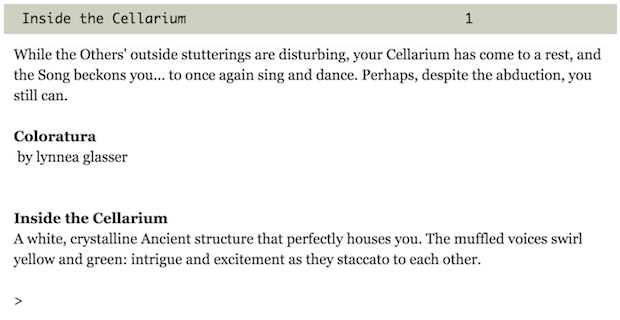IF Only: Alien Life
Four games about alien life
Stories about alien life raise interesting questions about what humans are, and whether there's any other way we could be; about communication between very disparate cultures, and whether it's even possible; about extremely alternate perspectives on earthly life. If you also like these stories, this week I have four pieces of IF about alien life forms to suggest:
Samantha Vick's The Axolotl Project tells the story of pharmaceutical research on a secret moon base. (The research has, inevitably, gone a bit wrong.)
A lot of the tropes in play are old and familiar ones: the corporation with a strong profit motive to mistreat its employees and lie to the public; the tampering with experimental evidence; the journal with pages ripped out for you to find elsewhere; plot-convenient placement of secret doors and locks. But The Axolotl Project deploys these familiar devices effectively, with a narration that is in turn unnerving and funny. Just occasionally the author lampshades just how tropey the elements are.
The Axolotl Project is in Twine, but the mechanics are reminiscent of parser IF -- or perhaps of a graphical point-and-click game. Pages represent rooms; you can travel back and forth through a consistent geography, though the contents of the rooms sometimes change in response to events. Characters are static until you choose to interact with them, at which point they offer menus of conversation, with some lines of dialogue becoming available only when you've made particular discoveries.
Meanwhile, there are areas of exploration that aren't on the critical path to finish the game, but that shed some useful light on the main characters. I especially enjoyed poking around the personal quarters of Crystal, a character who at first comes across as Delores Umbridge's Texan twin, but who in fact is something rather different.
The puzzles are generally of the find-object, use-object variety, but the point of discovery and the point of use are typically far enough apart that there's still room to make some realizations.
At the same time, the Twine implementation means that there are never any pixels to hunt for or verbs to guess, so the story kept moving at a decent clip. Once or twice I thought that I might be stuck, but there was always one last thing I wanted to check first, and always one new link available when I got there. And the choice-based interface is ideal for the game's handful of action sequences. That's an area where a parser often really struggles, because a player who takes INVENTORY during a fight scene, or even just makes a typo and gets an error message, can intentionally or unintentionally ruin the suspense. There are a few tricks for trying to tackle that problem, but in general, I find I enjoy playing IF action sequences more when I have just a few options and can move quickly. The Axolotl Project delivers well.
The result is a game that plays in some respects quite traditionally, but where tight pacing control keeps the story suspenseful and well-structured. I ran into a handful of typos, and there were a few places where it seemed the room description should have been updated to reflect a change in game state (including one spot where it kept mentioning that an area of the station was newly accessible, even after I'd passed through it a few times). But overall, this is a big, solid piece that kept me playing past my bedtime.
Coloratura (Lynnea Glasser) is another humanity-meets-alien-life-form story, this time involving an entity from the deep sea floor.
The twist is that this one is told from the entity's own perspective, which is deeply and genuinely not human. While this is hardly the first IF game from a non-human perspective — in Constraints, the player can even take on the role of a vase — Glasser's Aqueosity is one of the most surprisingly Other of IF protagonists. Physically, it's something like an intelligence-infused blob of water, though it can move on its own, think, sing, and detect and manipulate emotions, which it associates with colors.
You control the entity moving through the station, trying to escape, and manipulating human interactions that the player understands better than the protagonist. Some of the game's best moments trade on the disparity between intention and result, between the entity's understanding of the universe and the human understanding. Several of the puzzles require the player to think in both modes at once, about what would affect the humans (or human technology) and about what the alien is uniquely able to achieve.
There are two versions of this piece: the parser-based version that won IF Comp 2013, and a reimplementation in Twine. I played it in its original parser version and have a bias towards that implementation -- perhaps because that's the one I'm familiar with, or perhaps because it just does a better job, in my opinion, of letting the player freely explore being an alien life form. There are verbs to discover (the anti-parser contingent might say "verbs to guess"), and realizing that those verbs will work is part of the joy of play. But if you aren't a parser fan, the Twine is another possible route into the story.
Vesp: A History of Sapphic Scaphism is a Porpentine piece from earlier this year, commissioned by Vice. It is an extraordinary work, full of rich images and strange language.
Vesp's world is pestilentially overrun by wasps, and the protagonist is obsessed with wasps as well, both sexuality and identity focused on insect features. This interest is considered unhealthy by the surrounding culture, and the protagonist is being treated for this condition, but the wasp-longing never really goes away. Like the insects, the protagonist is both fragile and dangerous.
The fracturing of identity and intention carries over into the user interface. When you hover over a link, the linked word fractures into four versions of itself, making a swarm of options. Sometimes the content of the link changes as well — "don't touch" becomes "touch." Considering an action is the first step to making it possible, to putting that action within our reach.
Solarium (A. DeNiro) is one of the creepiest pieces of speculative fiction I've read, because within its framework of fantasy, alchemy, and interference from immortal spirits, it contains an element that is horrific-but-true: the story of Cold War hysteria and of how close we came to blowing ourselves up in the mid-20th century.
The premise is that a supernatural power presented itself to the most warlike elements of the US government during the height of the Cold War, and offered a perfect, inviolable protection against nuclear reprisals — one that would allow the US to make a definitive first strike against the USSR. Like all good Faustian temptations, the offer is one that reveals the worst traits of the tempted: fear, greed, aggression, monomania.
To go with this alarming plot, DeNiro writes confident and elegant prose, and understated but effective character interactions. Solarium feels literary.
Literary, and also documentary. Now and then the story is illustrated with a scan of some actual document about US strategy during the Cold War, or MKULTRA experiments, as a frequent and tangible reminder that Solarium is accurate to certain attitudes and policies, even if it doesn't describe actual events. The CIA did conduct experiments in which they used LSD on the population without warning; the US government did explore how well we could struggle on through a nuclear holocaust if necessary. The possibility of dying by the million, or killing by the million, was present and real and within the realm of acceptable thinking. And that is the most alien, most terrifying thing in Solarium, not the actual inhuman entities that participate in the tale.
[Disclosure: Emily Short has met Porpentine on several occasions; in addition, Porpentine used to write for this site. More generally, Emily is not a journalist by trade and works professionally with various interactive fiction publishers. You can find out more about her commercial affiliations at her website.]



